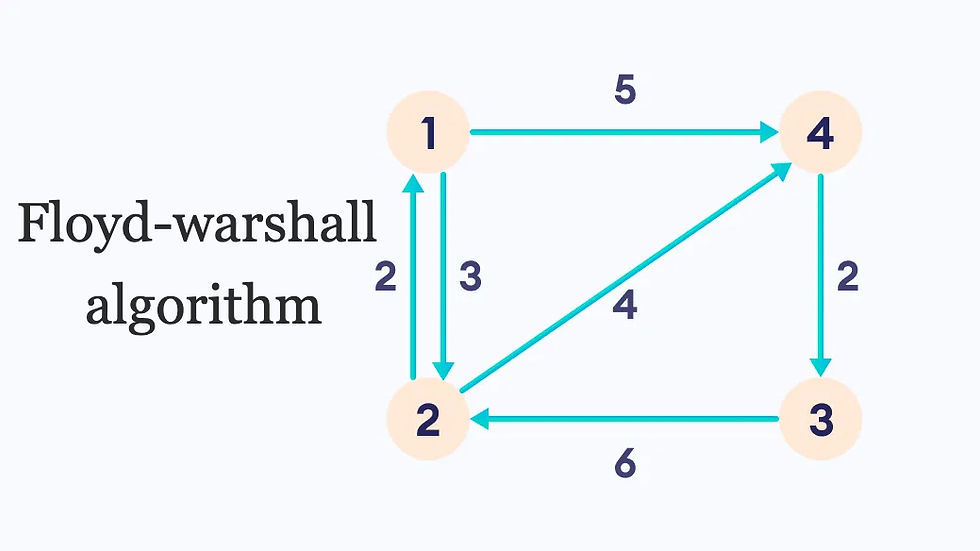Floyd-Warshall algorithm
- Emilia

- Aug 21
- 2 min read
Introduction
The Floyd-Warshall algorithm is a dynamic programming technique used to find the shortest paths between all pairs of vertices in a weighted graph. Unlike algorithms that find shortest paths from a single source (like Dijkstra's), Floyd-Warshall computes the shortest distance between every pair of nodes simultaneously.
Key Characteristics:
Works with both positive and negative edge weights (but no negative cycles)
Time complexity: O(V³) where V is the number of vertices
Space complexity: O(V²)
Uses dynamic programming with a bottom-up approach
Edge weight = the "cost" of traveling along that connection (distance, time, money, etc.)
A cycle is a path that starts and ends at the same node, going through other nodes.

Formula
The core recurrence relation is:
dist[i][j][k] = min(dist[i][j][k-1], dist[i][k][k-1] + dist[k][j][k-1])Where:
dist[i][j][k] = shortest distance from vertex i to vertex j using vertices {0, 1, ..., k} as intermediate nodes
i = source vertex
j = destination vertex
k = intermediate vertex being considered
Simplified 2D version:
dist[i][j] = min(dist[i][j], dist[i][k] + dist[k][j])Initialisation:
dist[i][j] = weight(i,j) if there's a direct edge
dist[i][j] = ∞ if no direct edge exists
dist[i][i] = 0 for all vertices
Usage
When to Use Floyd-Warshall
All-pairs shortest paths: Need distances between every pair of vertices
Small to medium graphs: Due to O(V³) complexity
Negative weights allowed: Unlike Dijkstra's algorithm
Dense graphs: More efficient than running Dijkstra V times
Transitive closure: Finding reachability between all vertex pairs
Common Applications
Network routing protocols: Finding optimal paths in communication networks
Game pathfinding: Precomputing distances in game maps
Social network analysis: Finding degrees of separation
Urban planning: Analysing transportation networks
Arbitrage detection: Finding negative cycles in financial markets
Algorithm Steps
Initialise distance matrix with direct edge weights
For each intermediate vertex k (0 to V-1):
For each source vertex i (0 to V-1):
For each destination vertex j (0 to V-1):
Update dist[i][j] if path through k is shorter
Result: dist[i][j] contains shortest distance from i to j
Example
A --3-- B
| |
2 1
| |
C --4-- DInitial matrix
A B C D
A [ 0 3 2 ∞ ]
B [ ∞ 0 ∞ 1 ]
C [ ∞ ∞ 0 4 ]
D [ ∞ ∞ ∞ 0 ]After running the algorithm
A B C D
A [ 0 3 2 6 ] ← A to D: A→C→D (2+4=6)
B [ ∞ 0 ∞ 1 ]
C [ ∞ ∞ 0 4 ]
D [ ∞ ∞ ∞ 0 ]


Comments